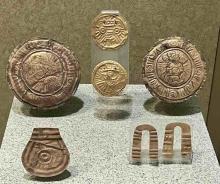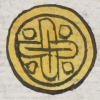coztic teocuitlapitzqui (Mdz70r)
This example of iconography from the Codex Mendoza shows a silversmith making objects of gold. He sits on a woven mat (petlatl) facing a three-legged container with a fire, where he is crafting objects in gold. Red and yellow flames shoot upward. A round disc that serves as the glyph for gold (teocuitlatl) appears on the edge of the container and at the front of the vessel.
Stephanie Wood
platero.
platero
Stephanie Wood
c. 1541, or by 1553 at the latest
oro, plata, oficios, metales preciosos
These hammered gold discs come from Michoacan. The round shape coincides with the round shape of the gold in the iconographic example above, even if the designs in the circles vary Copper was more common in Michoacan, but goldworking was known and some techniques were apparently learned from Ecuador and Peru. Hammering gold was more common than melting it. Museo Nacional de Antropología e Historia, Sala 10. Photo by S. Wood, 30 April 2025.
coztic teocuitlapitzqui, a silver worker who works gold, https://nahuatl.wired-humanities.org/content/coztic-teocuitlapitzqui
teocuitlapitzqui, a silversmith, https://nahuatl.wired-humanities.org/content/teocuitlapitzqui
coztic, something red, yellow, or gold, https://nahuatl.wired-humanities.org/content/coztic
coztic teocuitlatl, gold, yellow gold, https://nahuatl.wired-humanities.org/content/coztic-teocuitlatl
coztic teocuitlacozca(tl), a gold gem, https://nahuatl.wired-humanities.org/content/coztic-teocuitlacozcatl
platero
Stephanie Wood
Codex Mendoza, folio 70 recto, https://digital.bodleian.ox.ac.uk/objects/2fea788e-2aa2-4f08-b6d9-648c00..., image 150 of 188.
Original manuscript is held by the Bodleian Libraries, University of Oxford, MS. Arch. Selden. A. 1; used here with the UK Creative Commons, “Attribution-NonCommercial-ShareAlike 3.0 License” (CC-BY-NC-SA 3.0)





